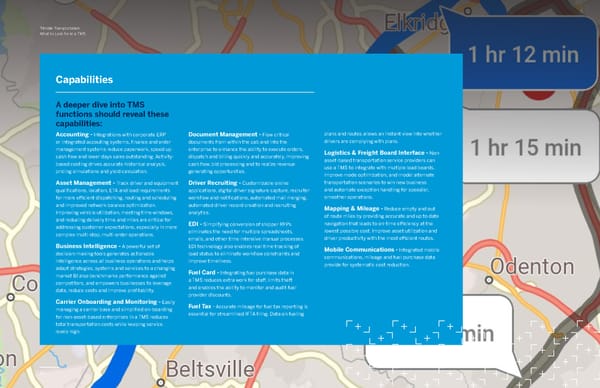11 Trimble Transportation What to Look for in a TMS Capabilities A deeper dive into TMS functions should reveal these capabilities: Accounting - Integrations with corporate ERP or integrated accouting systems, finance and order management systems reduce paperwork, speed up cash flow and lower days sales outstanding. Activity- based costing drives accurate historical analysis, pricing simulations and yield calculation. Asset Management - Track driver and equipment qualifications, location, ETA and load requirements for more efficient dispatching, routing and scheduling and improved network balance optimization. Improving vehicle utilization, meeting time windows, and reducing delivery time and miles are critical for addressing customer expectations, especially in more complex multi-stop, multi-order operations. Business Intelligence - A powerful set of decision-making tools generates actionable intelligence across all business operations and helps adapt strategies, systems and services to a changing market BI also benchmarks performance against competitors, and empowers businesses to leverage data, reduce costs and improve profitability. Carrier Onboarding and Monitoring - Easily managing a carrier base and simplified on-boarding for non-asset-based enterprises in a TMS reduces total transportation costs while keeping service levels high. Document Management - Flow critical documents from within the cab and into the enterprise to enhance the ability to execute orders, dispatch and billing quickly and accurately, improving cash flow, bid processing and to realize revenue generating opportunities. Driver Recruiting - Customizable online applications, digital driver signature capture, recruiter workflow and notifications, automated mail merging, automated driver record creation and recruiting analytics. EDI - Simplifying conversion of shipper RFPs eliminates the need for multiple spreadsheets, emails, and other time-intensive manual processes. EDI technology also enables real-time tracking of load status to eliminate workflow constraints and improve timeliness. Fuel Card - Integrating fuel purchase data in a TMS reduces extra work for staff, limits theft and enables the ability to monitor and audit fuel provider discounts. Fuel Tax - Accurate mileage for fuel tax reporting is essential for streamlined IFTA filing. Data on fueling 11 Trimble Transportation What to Look for in a TMS plans and routes allows an instant view into whether drivers are complying with plans. Logistics & Freight Board Interface - Non- asset-based transportation service providers can use a TMS to integrate with multiple load boards, improve mode optimization, and model alternate transportation scenarios to win new business and automate exception handling for speedier, smoother operations. Mapping & Mileage - Reduce empty and out of route miles by providing accurate and up to date navigation that leads to on-time efficiency at the lowest possible cost. Improve asset utilization and driver productivity with the most efficient routes. Mobile Communications - Integrated mobile communications, mileage and fuel purchase data provide for systematic cost reduction.
 What to Look for in a TMS Page 10 Page 12
What to Look for in a TMS Page 10 Page 12